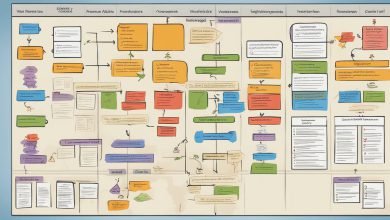
Product management is a complex process that involves various stakeholders, timelines, and goals. One of the critical aspects of product management is balancing vision with practical considerations while crafting a roadmap. Maintaining a clear vision throughout the product journey is crucial for success, but it is equally essential to ensure that the vision aligns with the company’s overall strategy and goals.
In this article, we will explore the importance of balancing vision in product management and crafting the perfect roadmap. We will discuss the role of vision in product management and provide tips and best practices to balance the vision while creating a roadmap. Additionally, we will explore the benefits of having a short-term and long-term strategy and techniques for communicating and aligning the vision with stakeholders and customers.
Key Takeaways:
- Balancing vision with practical considerations is crucial for success in product management.
- A clear product vision helps align the team, set goals, and make strategic decisions.
- An effective roadmap includes prioritization, timelines, and dependencies.
- Short-term and long-term strategies are essential for maintaining the balance in the roadmap.
- Effective communication and alignment of the vision are crucial for the success of the product.
Understanding the Role of Vision in Product Management
Product management is all about bringing a product to market and making it successful. To achieve this, product managers must have a clear vision of what they want to achieve with their product. A product vision is a guiding principle that defines what your product is and what it aims to achieve. It sets the direction for your product and provides a clear roadmap for the team to follow.
Having a clear vision helps in aligning the team, setting goals, and making strategic decisions. It also helps in creating a shared understanding of the ultimate goal for all stakeholders involved. However, it is important to balance the vision with practical considerations. A product vision that is not grounded in reality can lead to poor decisions and unrealistic expectations.
Product managers must find a balance between their vision and the practicalities of creating a successful product. Crafting a strong product vision involves understanding your target market, identifying their needs and challenges, and defining how your product can solve their problems. It is important to create a vision that is both ambitious and realistic.
Product managers must be able to communicate and share the product vision with all stakeholders, including team members, customers, and investors. This involves crafting a compelling message that resonates with people and inspires them to take action.
Ultimately, the vision is the driving force behind the product roadmap. It sets the course for the product and ensures that everyone is working towards a common goal. In the next section, we will discuss the process of crafting an effective roadmap and how it can help you achieve the product vision.
Crafting an Effective Roadmap
Creating a roadmap is a crucial step in product management, as it provides a clear plan and direction for the team. However, crafting an effective roadmap can be challenging, especially when it comes to balancing the product vision with the practical considerations.
Here are some key elements to consider when crafting a roadmap:
| Element | Description |
|---|---|
| Prioritization | Ranking the features and tasks according to their importance and urgency. This helps in focusing the team’s efforts on what matters most. |
| Timelines | Setting realistic deadlines for each feature and task. This ensures that the team stays on track and the product is delivered on time. |
| Dependencies | Identifying the dependencies among the features and tasks. This helps in ensuring that the team works on the right features at the right time. |
When crafting a roadmap, it is essential to balance the product vision with the practical considerations. Here are some tips and best practices:
- Start with the end goal in mind: Begin by defining the product vision and the outcomes you want to achieve. This helps in aligning the team’s efforts towards a common goal.
- Break down the vision into smaller goals: Divide the product vision into manageable chunks, each with its own set of features and tasks. This helps in creating a clear roadmap that the team can follow.
- Involve the team in the process: Collaborate with the team to gather their inputs and feedback. This helps in creating a more realistic and achievable roadmap.
- Review and update the roadmap regularly: Revisit the roadmap periodically to ensure it is still aligned with the product vision and the changing market conditions.
Crafting an effective roadmap requires a balance between the product vision and the practical considerations. By following these tips and best practices, product managers can create a clear and achievable plan that leads to success.
Balancing Short-Term and Long-Term Vision
One of the key challenges in product management is balancing short-term goals with long-term vision. It can be tempting to focus solely on immediate needs, but neglecting the long-term strategy can have negative consequences.
On the other hand, a product roadmap that only focuses on the long-term vision can lead to unrealistic expectations and the team losing sight of immediate goals. Therefore, it’s crucial to strike the right balance between short-term and long-term vision.
One strategy for achieving this balance is to break down the long-term vision into smaller, achievable milestones. This allows for progress to be made towards the ultimate goal while also accomplishing short-term objectives.
Another tactic is to prioritize projects that have a balance of short-term impact and long-term benefits. By doing so, the team can see tangible results in the short term while still making progress towards the long-term vision.
The product roadmap is a helpful tool for balancing short-term and long-term vision. It should include both immediate goals and long-term objectives. The immediate goals should be aligned with the long-term strategy, and the long-term objectives should be broken down into smaller milestones.
Finally, communication is key to maintaining the balance between short-term and long-term vision. The product manager should regularly communicate the long-term vision and strategy to the team and stakeholders, while also acknowledging and celebrating short-term wins.
Summary:
- Balancing short-term and long-term vision is crucial in product management.
- Breaking down the long-term vision into achievable milestones can help maintain the balance.
- Prioritizing projects with both short-term impact and long-term benefits is another effective tactic.
- The product roadmap should include both immediate goals and long-term objectives.
- Regular communication is essential for maintaining the balance between short-term and long-term vision.
Communicating and Aligning the Vision
Effective communication and alignment are essential in product management. Without them, the product vision can be unclear, and the roadmap can become disjointed. Here are some tips for communicating and aligning the vision:
- Be clear and concise: Use clear and concise language when communicating the product vision to stakeholders, team members, and customers. Avoid using technical jargon that may confuse people.
- Use visuals: Visual aids, such as charts, graphs, and diagrams, can help communicate the product vision more effectively. They can also help align the team and stakeholders around the same goal.
- Get feedback: Encourage feedback from team members, stakeholders, and customers to ensure that the product vision is aligned with their expectations. This can prevent misunderstandings and misalignment down the road.
- Regular check-ins: Regular check-ins with team members and stakeholders can help ensure that everyone is on the same page and that the product vision is being executed effectively.
- Align the roadmap: The product roadmap should be aligned with the overall product vision. This ensures that the product is moving in the right direction and that short-term goals are aligned with long-term goals.
By following these tips, you can ensure that the product vision is communicated effectively, and the roadmap is aligned with the overall goals of the organization. This can lead to a more successful product and a more cohesive team.
Conclusion
Product management is a complex process that requires a delicate balance of vision and practicality. Crafting the perfect roadmap involves maintaining a clear vision of your product while considering the practicalities of execution.
In this article, we explored the importance of balancing vision in product management and provided insights into how to create an effective roadmap. We delved into the role of vision in product management and the challenges of balancing it with practical considerations.
We discussed the key elements of a roadmap, including prioritization, timelines, and dependencies, and provided tips and best practices for balancing the vision while creating a roadmap. We emphasized the importance of balancing short-term and long-term vision in product management and explored the benefits of having both immediate goals and a long-term strategy.
Communicating and Aligning the Vision
Effective communication and alignment are crucial when it comes to the product vision. Techniques for communicating the vision to stakeholders, team members, and customers were discussed. We also explored how to align the roadmap with the overall vision of the organization.
In conclusion, maintaining a clear vision while planning the journey of a product is critical for success. Balancing vision in product management and crafting a roadmap that aligns with the vision are essential components of the product management process.
FAQ
Q: What is the importance of balancing vision in product management?
A: Balancing vision in product management is crucial as it helps align the team, set goals, make strategic decisions, and ultimately lead to the success of a product.
Q: How can a clear vision help in crafting an effective roadmap?
A: Having a clear vision allows product managers to prioritize, set timelines, and identify dependencies, resulting in a well-crafted roadmap that aligns with the overall product vision.
Q: What are some challenges in balancing the product vision with practical considerations?
A: Some challenges in balancing the product vision with practical considerations include resource limitations, market demands, and technological constraints. Finding the right balance is essential for success.
Q: Why is it important to balance short-term and long-term vision in product management?
A: Balancing short-term and long-term vision allows product managers to focus on immediate goals while also considering the long-term strategy for sustained growth and success.
Q: How can effective communication and alignment support the product vision?
A: Effective communication ensures that the product vision is clearly conveyed to stakeholders, team members, and customers. Alignment helps ensure that the roadmap is in line with the overall vision of the organization.
Q: What are the key points to remember about balancing vision in product management and crafting a roadmap?
A: It is important to maintain a clear vision while planning the journey of a product. Balancing the vision with practical considerations, communicating effectively, and aligning the roadmap with the overall vision are key to success.








